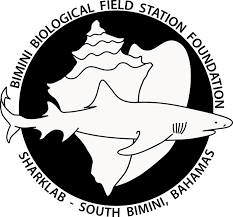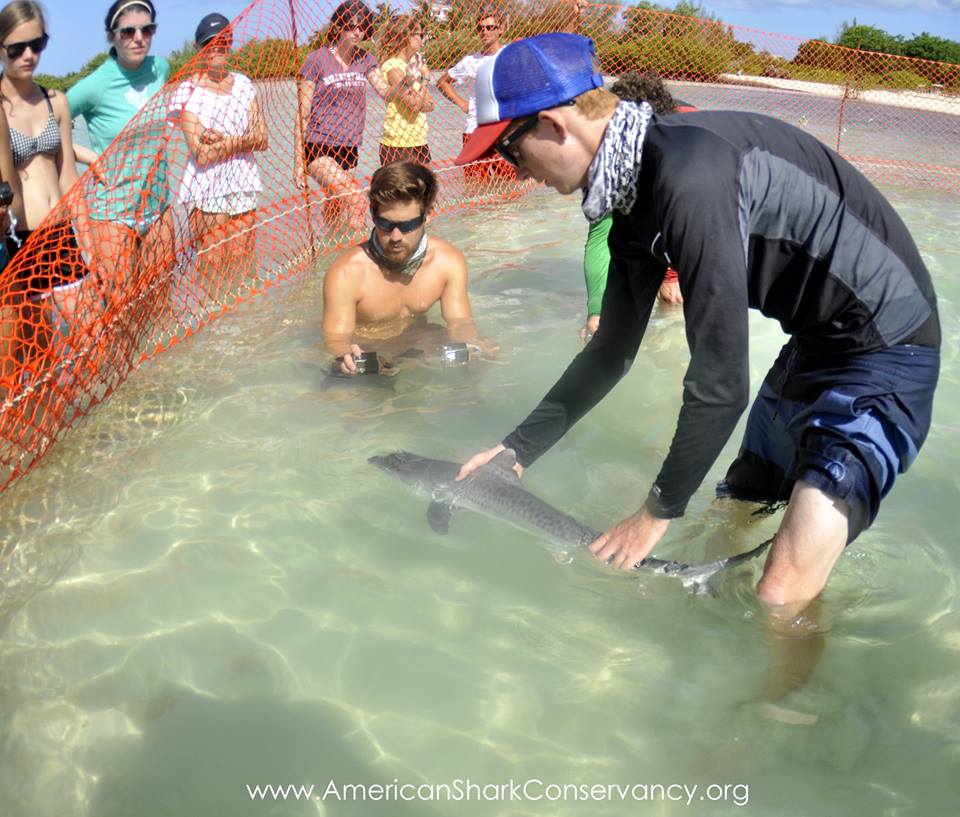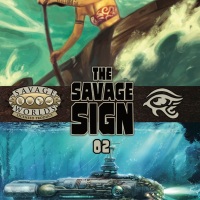Playing With Sharks
Playing with Sharks
© 1992 Brian Reeves

In August of 1992, I was in the Bahamas for a scientific expedition, upon which I was serving as one of about twenty-five volunteers. We were with the organization Earthwatch, assisting graduate students researching the nature of adolescent lemon sharks on the tiny island of Bimini, on the far western end of the Grand Bahama Bank. Our job was to be pretty simple: the graduate students, working under University of Miami biologists, were studying the lemon sharks in an effort to understand how they managed to locate their home range. They lived in mangroves, which were essentially salt water swamps full of strange trees which grew above the water line. The trees shot roots down through the water to anchor in the sludgy sediment two or three feet below. The effect was a tree on stilts. Spindly roots came up just out of the water line, where they came together to form the trunk of the tree. Broad branches with tiny green leaves created a shady canopy, keeping the heat and insects in. Birds and mangrove crabs dwelled in these swamps, but so did adolescent lemon sharks.
Sharks, unlike other fish, are viviparous, which means they give live birth. Usually there are eleven or so pups in a litter. The young pups stay close to the area they were born, while the mother abandons them and heads back out to sea. Most die off in the first year, and those that remain haunt the same one- or two-mile stretch of mangroves. They eat fish and other animals in the brackish water. One of the most misunderstood of the world’s creatures, this type of shark also had a behaviour which had boggled researchers for some time: the young sharks, when taken far outside their normal range, were capable of finding their way back to it with little difficulty. The route they took was tortuous and confused, at best, but regardless of distance, time, season, or weather, they were capable of homing back on the same home range within twelve hours or so. When looked at on paper, the pattern sure looked like random exploration on the shark’s part, but randomness could never account for the homing, time and time again, of the subject shark on its home range. Given total randomness, the shark would just as likely end up in Florida or nearby Andros Island as not. The students and staff from the University of Miami had been working on the how of this problem, to better understand the abilities of sharks.
That was where we came in. We paid our dues (a whopping $1,800 dollars!) and flew to Miami where we were taken over to Bimini. We were there to help them with menial tasks, and to provide extra hands when the students weren’t enough. We were to help them net the sharks, track them, and study them, but we were also there to cook, clean, and haul things. Despite the high price tag, it was volunteer work, and we were ready to do our part in uncovering this mystery.

Flying low over Bimini, I looked across its entire expanse easily, half of it visible out of my side of the plane at any given time. The whole island was only a few miles long; really it was nothing more than a sand bank with some trees and buildings on it. But the relaxing turquoise of its waters gave it the appearance of a tiny gem in the Atlantic.
We stayed in a glorified trailer near a mangrove-infested lagoon. The spit of land the station was nestled on was half sand, half trees and had commanding view of the stagnant water of the lagoon, but if you were to walk a few yards behind the station through the bushes, you would emerge on the sands of a tranquil arching bay with waters clearer than you thought possible.
Not long after our arrival, a handful of us went down to the waters to swim and explore. The waves in the protected harbor were shallow, and lapped at our heels gently. Sunlight reflecting from the smooth sand warmed the water to near Jacuzzi temperatures: during August the water averaged 90 degrees Fahrenheit. It was wonderful to wade around in, but a few of us wondered if the water would keep its temperature at night. After sunset we went down in our swimsuits and plunged in. The water was still bath-like, only now, with the western sky deepening to a Technicolor blue, the waves glowed with the peppermint spark of bioluminescence. As we trailed our hands underwater, comet-tails of glitter would scatter behind.
A couple of days later, I returned to the beach alone when I had some time to spare. The sun was blissfully warm on my skin and rode nearly directly overhead. I was wading only a little way into the water, still in disbelief over the warmth of it, when I noticed a dark patch to my right. Merely an underwater rock or patch of turtlegrass, or so I thought, until I noticed it was moving. It drifted closer at a leisurely pace, but I wasn’t afraid; the water was very shallow and I was only a few yards from the sand. At last this black shape drew near and I could finally tell what it was: a skate, a relative of the shark, but flat and winged, and much smaller (skates belong to the order hypotremata, and sharks are pleurotremata.) This skate had taken an interest in my ankles and was coming to investigate. It did a couple of loops around my heels, slowly, not realizing at first that I was alive. I stood stock still and watched, wishing I had brought my camera, and then I noticed another approaching. It joined the first one for a quick inspection, then the two diamond-shaped critters split up and floated back into the deeper waters.
•
Collecting the sharks for the research was not a great deal of fun. It involved going out in a squadron of boats to a mangrove-lined area along the central lagoon of Bimini (much larger than the tiny lagoon we were stationed near) and locating one of their experiments with a sonic device. The device was called a “hydrophone,” and it looked an awful lot like a serving bowl taped to the end of a piece of PVC pipe. Sound waves traveling through the water would reflect off the bowl into a central microphone, to then be transmitted to a pair of heavy-duty headphones the operator would wear. The sharks had been previously caught and an object called a “pinger” was surgically inserted into their body cavity. The pinger was about the size and shape of a shotgun shell. It was equipped with a battery that would last a couple of years at least, during which time the pinger would constantly emit a low-level sonic ping (hence its name) that did not disturb the shark or its behavior in any way. The ping merely allowed the shark to be located using the hydrophone.

Once found, the shark had to be corralled in a semicircle of netting and brought onto the largest boat for immediate capture. It would be flipped onto its back to induce it into a state of “tonic,” a sort of coma for sharks. It is then taken to the holding pen. Much later, after a “cool-down” session, the shark would again be taken, in tonic, far out to sea. There it would be released and tracked in the attempt to determine how the sharks could find their way back to the same home stretch of mangrove. Since this was usually a long and tiresome process, the pursuit would be done in three phases, each one done by a different relief crew.
Our second day in Bimini we finally went in search of a shark. We circled the island in two little boats, following the mangroves lining the central bay until we finally heard a ping. Pretty soon, we had taken a large net out of a garbage can they used as a container, and had stretched it in a huge semi-circle forming a phalanx along one section of mangrove. One of the sharks, dubbed “Chewie,” was out there somewhere in the knee-deep water, skirting the mangrove trees. By the time we finally caught him, the thick sediments at the bottom had nearly pulled off my shoes and I had begun my sunburn in earnest. They kept the comatose shark in an Igloo cooler; they had to get it to a holding pen as soon as possible to prevent damage to the tissue. The holding pen was a ring of pegs and webbing in waist-deep water right offshore from the shark lab. Chewie would wait there, circling and circling, until we were ready for him.
That night they began the experiment. They took the big boat and headed far out to sea, east by southeast, Chewie relaxing upside-down in the cooler. The lab had a central radio, and volunteers were randomly picked to man it. I was picked for the first shift, then my job was taken over so I could get some sleep. About four in the morning we awoke and headed out on our relief crew mission. It was then when I saw the single most splendid sunrise I have ever witnessed.
It was still warm outside even in the last hour of night, but as the boat started out of out little harbor, the wind brought a bit of a chill. Combined with spray splashing up from the bow of the boat, I began to actually shiver. I huddled near the bow, wishing I could move back to one of the other benches. As we plowed eastward, the sky began to turn purple, then a deep blue, then with astonishing rapidity, burst into a range of reds, pinks, blues, oranges, and purples. This rainbow was broken up by lazy smears of clouds high overhead, colors splashed across their undersides. The thing I remember most is how tall it was: it seemed to start in a somewhat narrow base that wrapped across only about a quarter of the horizon, then built upward in a column that ran through the spectrum, darkening to a deep purple only directly overhead. They brought the little boat to a stop, and in my sleepy state I felt I had drifted back into dream. Even out here the waves were small and quiet, so there was only us and this immense sunrise painting us gold, the land a low strip of dark green far behind, and the clear water below, through which you could see the rolling sands of the bottom twenty or thirty feet below.

I never made it to the main boat: just after the sunrise, before we had even located the other boat, they lost Chewie in the waters and the experiment was scrapped. Presumably, he managed to reach his home range, but he had simply eluded the researchers and their hydrophone. It wasn’t surprising – the sea is alive with noises, like the clicking of small shrimp in the turtlegrass beds, which came across as static in the earphones. There would be another experiment later. I didn’t mind – even though I had missed out on some sleep.
•
The Lemon shark, negaprion brevirostris, is indigenous to the area, and has a range stretching from the New Jersey coastline all the way to Brazil, and even a little in the Pacific. They can grow up to ten feet in length, and usually weigh about 265 pounds. I didn’t know much about sharks when I went, and was a little timid about getting into the water with them. The day after going out for drinks in the main town, we split all the boats up and went in search of some more sharks, these in wildly different sections of the island. Four of us climbed into a tiny boat and picked our way along the southern shore, pretty close to base. The alcohol I had imbibed the night before, combined with the relentless tropical sun, created an eye-blearing headache. We found no sharks, and instead ended up running our boat aground on some rocks. Fortunately, another boat came back with another shark. In the afternoon my headache had cleared a little, so I went to go see it.
I waded out to the shark pen. One shark, about the length of my arm, lazily swam the perimeter. That was the first time I got a real good look at one. I climbed a little ladder built into one side and peered down at it.
It was shaped about like the sharks I had seen before, but it had a second dorsal fin almost the same size as the first one. The skin was dark brown. Adult Lemon sharks have a yellowish tinge to their skin, which is where the name comes from. I remembered touching some shark skin in the lab: when rubbed one way, it was smooth and leathery, like tanned hide. But when rubbed the opposite direction, thousands of tiny spines, called dermal denticles, could be felt. The term means “skin teeth,” and it is accurate – the tiny spines are akin to teeth, and are imbedded in the skin of the shark, forming a texture quite unlike the scales of fish. I wanted to touch the one in the water but didn’t dare. Frankly, even though they had told us most sharks are essentially harmless to humans, it was still unwise to provoke them. I climbed back down off the ladder and headed back to shore.
In retrospect, I wish I had climbed down to touch it. The shark was small, and probably far more afraid of me than I was of it. It could certainly see me: sharks’ eyes allow them to see objects fairly well above the water, a boon when scavenging the surface for food. Dr. Gruber, one of the most internationally well-known shark biologists, had given us some pointers on shark behavior, and he pointed out that sharks almost never attack for unknown reasons. Usually, they are prompted to attack by the presence of blood; sharks of all varieties can smell as low as one part per million of blood in the water. That means a significant amount of blood in the water, given the right currents, could attract sharks from as far away as seven miles. In addition, they are sensitive to vibrations: heavy thrashing can induce them into an instinctive eating frenzy. At the same time, cases have been documented of shark attacks being repelled by the victim shouting at the shark underwater. Sharks have delicate acoustic wave detectors in their snouts; any attack upon the shark focused on their snout will usually result in the surprised and stunned shark taking its appetite elsewhere.

But I didn’t think about those things when I was looking down at out captured shark. He swam in lazy circles, round and round, no doubt peering up at me the whole time. If I had known, as I waded away, that it would be the last time I saw a shark during my visit, I might have gone back.
Four days after our arrival came the news: tropical storm Andrew had been upgraded to a hurricane and was plowing through the Bahamas, making a bee-line for Bimini. We were evacuated in a few hours and spent four days in Miami, scrounging for food. The last four days of our visit, we managed to get back to Bimini. The station was still mostly intact, actually having suffered less damage than the house we stayed in. Little was missing, and there was only a couple of hours’ worth of debris to clean up. But distant Cat Cay, about ten miles to the south, had been obliterated, everyone on the island killed when the raging seas came up and covered it. Million-dollar homes were wiped out down there, but on Bimini there was only branches in the road and some toppled equipment.
We tooled around, assessing the damage. Not surprisingly, the terrific winds and waves had erased all three shark pens. We boated out to a shark cage they had submerged underwater: it was originally octagonal, about twelve feet wide, and a few feet thick. When they found it, even where it was anchored thirty feet underwater, it had been crumpled into a ball like so much tin foil.
Of the sharks there was no sign. The last afternoon, in the torpid heat and humidity, we split up once more to go on a shark hunt, only this time, there would be no capture. Of eight tagged sharks who made their home ranges in the mangroves of Bimini Island, we found three. Whatever happened to the others we never could ascertain, but if the fate of the octagonal shark cage was any indication, it couldn’t be good.
If there was a lesson to be learned in all this, perhaps it was that nature was, in the end, unknowable, and untamable. We had lost our sharks – but were they really gone? Had they survived the storm by fleeing elsewhere, or had they been pulled far out to sea by the churning waters? Would they ever return to their idyllic strip of mangroves?
•
Hoping for some reminder of the beauty I had seen before, I walked behind the station down to the soft harbor I had grown to love. The winds, however, had marred its crystal clarity: silt from the bottom had been stirred up and now the water was a light brown stew. I would never see the bottom of the bay again.
Years later, I saw an article in Newsweek about Gruber and his graduate students. It seems the mystery had been solved: the sharks had a gland which enabled them to sense magnetic field lines, much like migrating birds do. The Earth is covered with these lines, which radiate from the magnetic poles like apple slices. The content of the Earth is largely metallic, with a dense core of iron and nickel. One of the properties of iron is that it has a tendency to “align” in the same direction. On a large scale, this means our planet is, essentially, a huge magnet, with both a positive and negative pole. The sharks – those little, baby sharks – were able to sense these lines almost like the currents of the water itself, and use them as guides back home. Simple as that.
I watched Bimini fade behind us as we flew out, our time over. Instead of the disk of turquoise, now it was ringed with a watery, sandy halo, deepening to normal blue where the shallows dropped off into the Florida Channel. It would gradually return to normal, and the sharks would come back out of their mangroves, and the conch would pull themselves back out of their shells, and the skates and tuna and dolphins would swim the shallows, and the phosphors would once again gleam in the tropical moonlight, but I wouldn’t be there to see it.





